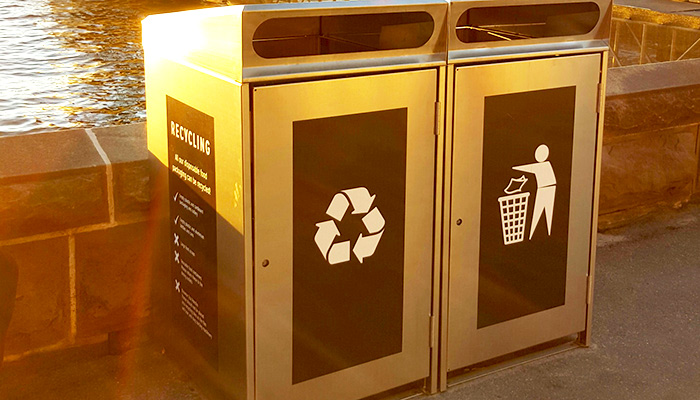
Recycling has been a growing concern among Australians for many years. Whether at home or at work, people are increasingly putting in the effort to help protect and preserve the environment.
Public parks are an area where members of the local community can spend time socialising, playing sport and coming together. Our public areas and parks should be treated like our homes. After all, you wouldn’t throw your rubbish on the floor at home!
Keeping a park clean is a collective responsibility that all park visitors and community members should contribute to. If everyone is mindful to throw their rubbish away, this ensures our public spaces stay clean. As a result, our public spaces become more pleasant and enjoyable places to spend time, for everybody. This is why providing the necessary recycling and waste disposal bins is so important.
Australia has one of the highest waste generation per capita rates in the whole world – the average Australian produces approximately 2 tonnes of waste per year! If this waste is not disposed and recycled properly, it can end up going in landfill. This can cause severe damage to the surrounding environment.
While many public parks have implemented recycling bins, the lack of clear visuals and guidance can be confusing. This results in many recyclables ending up in landfill. For this reason, providing accessible, clearly marked recycling bins and bin enclosures in public parks is crucial.
Keeping Australia’s Parks Clean and Rubbish Free
The NSW Department of Environment and Conservation reports that according to a Beverage Industry Environment Council survey, nearly 50% of people say they litter because they’re too lazy or there is no bin available. The report also states that ‘standard colours and clear signage are essential for running successful public place recycling collection services. The signs should communicate by colour, symbols and words.’
Without providing identifiable recycling bins in parks, it is likely that people will continue to use incorrect bins. However, by simply placing easily identifiable litter and recycling bins in public parks, we can help to provide a solution. This will contribute to cleaner public spaces and more sustainable environment.
Additionally, recycled plastic is now being used to make battens. We use the material in picnic tables, benches, security bollards and even drinking fountains. At Draffin we’re proud to offer a wide range of street and park furniture that are now made from recycled materials.
We are moving in the right direction…
According to MRA Consulting Group’s State of Waste 2016 report, in Australia, almost 60% of waste is now recycled. However, 40% of our waste is still ending up in landfill.
Statistics that show a positive trend towards recycling adoption with recycling rates steadily increasing since 2005. This reflects a decline in the amount of waste going to landfills. To keep this positive trend moving in the right direction, recycling bins need to be accessible.
Local Recycling Issues
Often recycling bins are there, but they simply are not being used as intended.
The City of Ballarat has recognised that their community has not been using recycling bins correctly. The Courier reports that almost 18% of rubbish put in their yellow-lid public recycle bins actually ends up in landfill.
A spokeswoman for the city of Ballarat confirmed there were non-recyclable items in the yellow lidded bins.
The Victorian Government has conducted extensive research on the recycling habits of Melbourne residents, which revealed that while most people are generally very enthusiastic about recycling, a combination of situational and knowledge barriers can affect how well they recycle. Confusion arises when waste streams are hard to identify.This can result in incorrect disposal or people simply ignoring the option.
Providing Clear Labelling Guidelines
We know that implementing recycling bins into public parks is important. But how can we encourage good recycling habits and ensure the public use them properly?
To clear up confusion when it comes to public recycling, we need to make bins easy for people to use. One solution is to provide clear and informative guidelines that reflect current waste strategies.
Research at the Univeristy of Melbourne found that there was a definite trend in positive recycling rates when recycling bins labels were both clear and unobstructed. They found an average of just over 10% of recyclables went to landfill when signage was fully visible, versus a massive 25% when there were no clear labels.
It is important we are using identifiable visuals that inform park visitors exactly what goes in each bin.
This includes
- Specific colours associated with recycling
- Product specific images and wording
- Including the universal symbol for recycling
Draffin Street Furniture provides a range of recycling bin enclosures that have clear pictures and guides on what rubbish should be placed in each bin. Below are some examples of Draffin’s effective recycling options.
Examples of an ideal design that is a marked, colour identifiable recycling bin:
- Infinity Series
- 1500 Series
- Bin Corral
The key to fostering good recycling habits is to make it easy for the public and the community to use and understand – this includes images that cross language barriers, as well as bright and vivid colors so people can identify the bins.
Our public parks provide a welcoming environment for the community to come together and enjoy. It is up to each person to do their part to recycle properly.
Implementing a clearly recognised recycling plan in our public parks is a crucial component in protecting the environment. Draffin’s range of recycling bins helps to provide an effective litter solution. Our product range provides clearly labelled bins, with a variety of icons, colours and text. This makes recycling an easy task for everyone in your community.
To learn more, you can view Draffin’s line of recycling bins here.





